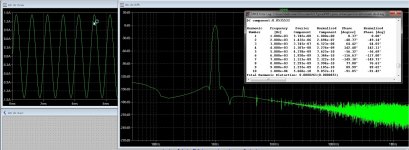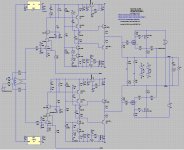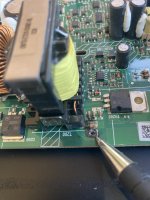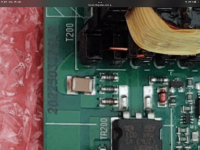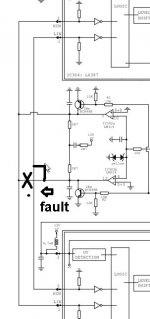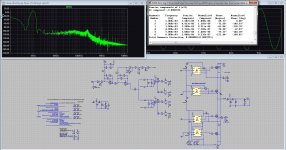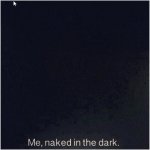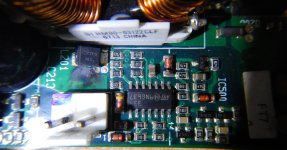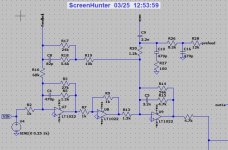On one hand you're probably right that you can find many other amps that subjectively give a better sound quality.
On the other hand I think you are concluding on sound impressions by looking at measurements which is always a bit dangerous. You're also well on the way to concluding that class D in general is no good, based on measurements of just one specific amp which is also misleading.
To add to that I think comparing an 200W class D integrated amplifier the size of a lunch box with a huge class A or tube amp power amp isn't really a fair (or usable) comparison. I doubt a lot of people would really consider these as direct substitutes, even if they both play music 🙂
On the other hand I think you are concluding on sound impressions by looking at measurements which is always a bit dangerous. You're also well on the way to concluding that class D in general is no good, based on measurements of just one specific amp which is also misleading.
To add to that I think comparing an 200W class D integrated amplifier the size of a lunch box with a huge class A or tube amp power amp isn't really a fair (or usable) comparison. I doubt a lot of people would really consider these as direct substitutes, even if they both play music 🙂
Electrolytics with small voltage value below 25VDC (like 16VDC on this PCB - go to the images under
ICEpower 200AC Class D Audio Amplifier Module 1 x 200W)
have always short life time particularly in SMPS and Class-D amplifier applications.
SMD versions additional haven't logo from manufacturer - i.e. extremly cheap and bad quality at the same time in most cases.
Good solution is the use of 63VDC versions and bypass foil type (e. g. WIMA MKS between 220nF and 470nF). Unfortunately on this PCB isn't enough space therefore.
Hi!
I have "flapping speaker" on my ICE 200AC. Couldn you tell me please, about what capacitors you are talking about in text above (sorry for my english)
What is so special about Icepower MECC? just cascaded feedback system who is already used on much papers, now Gan is here the need of such strong feedback is not needed, even open loop it does -70dB because of tight deadtime and clean switching.Here the attachement
Unclebuck, this icepower is possible three level, and I see the fault on the inputs to dricer ic from lm319 comparators, outputs are connected, but needs one to High and one to Low input.
COM self oscillating was already done much times.
Using flattened integrators will make audio better, the integration does not work on the audio band who is better, integration is used for error correction of output stage switching errors, no need to integrate audio, that is much better for sound, some downdraft is less open loop voltage so need cascaded, nested feedback..On one hand you're probably right that you can find many other amps that subjectively give a better sound quality.
On the other hand I think you are concluding on sound impressions by looking at measurements which is always a bit dangerous. You're also well on the way to concluding that class D in general is no good, based on measurements of just one specific amp which is also misleading.
To add to that I think comparing an 200W class D integrated amplifier the size of a lunch box with a huge class A or tube amp power amp isn't really a fair (or usable) comparison. I doubt a lot of people would really consider these as direct substitutes, even if they both play music 🙂
What is so special about Icepower MECC?
I don't like Class-D in general and don't know, what is very special here.just cascaded feedback system who is already used on much papers, now Gan is here the need of such strong feedback is not needed, even open loop it does -70dB because of tight deadtime and clean switching.
Unclebuck, this icepower is possible three level, and I see the fault on the inputs to dricer ic from lm319 comparators, outputs are connected, but needs one to High and one to Low input.
COM self oscillating was already done much times.
Bruno Putzeys know the theory of operation in detail.
As I know, genuine schematics are published in the meantime because this modules more than 15 years old.
I do not yet now, but I did not find schematics of icepower, except a pcb redrawn without capacitors valeu,s but these van be calculated easely,.I don't like Class-D in general and don't know, what is very special here.
Bruno Putzeys know the theory of operation in detail.
As I know, genuine schematics are published in the meantime because this modules more than 15 years old.
Though this circlotron I have with autobias is still extreme low in distortion, as in simulation, not yet real, corcona is a little a culprit here.
Class d however is interesting to look at, but seems that extended op low gain is needed, and this big feedback I do not now it sounds good, I do however see interesting things in Gan.
Attachments
You can make higher impedance by changing feedback resistors, I believe she use 1 k with a 68 K for 68 x closed loop (example), you can use 2.2 k with 150 k.I highly doubt the Icepower ASC200 in the Rotel was any different from the stock implementation of the ASC200. I have opened the Bel Canto S300 and found the same ASC200 with nothing changed.
The Rowland 501 has an input buffer added to a stock ASP1000 to increase the amps input impedance to 40k - if there's anything bad to say about the Icepower amps, including the ASP1000, is its low input impedance...limits the possibilities of a preamp...Tube preamps with output impedance over 1K are not going to match well, while most SS will do fine.
When you heard the Bad Icepower ASC200, it didn't happen to have a tube preamp in front? Pretty much the only thing that you can trip up is a wrong preamp. The UCD Amps have a much higher iinput impedance and will work well with any and all preamps...
Hi all
my subwoofer I blowing fuses , and the cause is this component which is blown, I can see others have the same problem,
https://www.diyaudio.com/community/...rev-engin-not-complete-finished.153786/page-3
before I go of and buy a new board , then I would like to know if anyone knows the component type and value ? (Enclosed is my board with the one point on the faulty component and a picture of a new board)
I have been searching the internet high and low for a schematic of the board and components , no luck though.
It is hard to find the board for sale in Europe / Denmark
all I found is this , which is out of stock until dec,
https://www.soundimports.eu/en/icepower-200asc.html
any help is appreciated
BR Poul
my subwoofer I blowing fuses , and the cause is this component which is blown, I can see others have the same problem,
https://www.diyaudio.com/community/...rev-engin-not-complete-finished.153786/page-3
before I go of and buy a new board , then I would like to know if anyone knows the component type and value ? (Enclosed is my board with the one point on the faulty component and a picture of a new board)
I have been searching the internet high and low for a schematic of the board and components , no luck though.
It is hard to find the board for sale in Europe / Denmark
all I found is this , which is out of stock until dec,
https://www.soundimports.eu/en/icepower-200asc.html
any help is appreciated
BR Poul
Attachments
https://www.profusionplc.com/parts/icepower200asc they are in stock.Hi all
my subwoofer I blowing fuses , and the cause is this component which is blown, I can see others have the same problem,
https://www.diyaudio.com/community/...rev-engin-not-complete-finished.153786/page-3
before I go of and buy a new board , then I would like to know if anyone knows the component type and value ? (Enclosed is my board with the one point on the faulty component and a picture of a new board)
I have been searching the internet high and low for a schematic of the board and components , no luck though.
It is hard to find the board for sale in Europe / Denmark
all I found is this , which is out of stock until dec,
https://www.soundimports.eu/en/icepower-200asc.html
any help is appreciated
BR Poul
@PoulBrandt did you manage to fix your Icepower module?
I use the same model as you, 1 for each of my 2xRCF 15" subwoofer
I've successfully done repairs on both Icepower board
I do have the schematics, but I can't send it to anyone, due to a promise I made to my friend, who works at icepowe
But I can answer your questions regarding component value
Br Martin
I use the same model as you, 1 for each of my 2xRCF 15" subwoofer
I've successfully done repairs on both Icepower board
I do have the schematics, but I can't send it to anyone, due to a promise I made to my friend, who works at icepowe
But I can answer your questions regarding component value
Br Martin
There was a fault in the schematic, now corrected, maybe the two connections have to switch each other for proper fase. I am very supprised how you did create this with a multilayer board, clever. For me there is not much special on the modules qua technology, it does let see how non liniair the pwm system is when there is the need of so much feedback, not oke for sound, except if fase liniarity is well on 0.01dB to 100 Khz, feedback does not impact. But that is never the case except for liniair amps. Promising Gan mosfets are however now available, evenwithout feedback it get -70dB hd. But you need small vingers to use them.Here the attachement
Attachments
I think there were a lot more mistakes in the drawing I was trying to do 14 years ago.
genuine B&O schematics still no available ?
genuine B&O schematics still no available ?
The simpler the schematics are, the more reason to keep them secret (obviously) - at least if you want to run a profitable business 😉
If you look at the schematics, all have some of the same others have, the feedbacksystem is for all class D of
a kind of Pi. Promissing are the Gan, and the need of just low feedback, keep fase coherent and the feedback has no
negatieve effect.
In the close future the products need to make it possible to repair, this is because of the greener future.
I have simulate the MeCC from a schematic you had placed here and the read of the Patent and some calculations.
a kind of Pi. Promissing are the Gan, and the need of just low feedback, keep fase coherent and the feedback has no
negatieve effect.
In the close future the products need to make it possible to repair, this is because of the greener future.
I have simulate the MeCC from a schematic you had placed here and the read of the Patent and some calculations.
Attachments
Help identify the parts on the ICEpower 200ASC board (AMP+SMPS):
1) Diode(?) marked "ON 709 MX."
The "+" of the "diode" is connected to +47V (AMP VCC) and the "-" to GND. I wonder why.
2) IC marked "ST 339 9NGB37 or ..637", to understand what is it for.
+/- 12V on the board is ok, +47V is unstable (SMPS turns on and off). Also 2 transistors 400N06N in AMP are shorted and the SMD safety resistor "R020" for AMP VCC is burnt out.
1) Diode(?) marked "ON 709 MX."
The "+" of the "diode" is connected to +47V (AMP VCC) and the "-" to GND. I wonder why.
2) IC marked "ST 339 9NGB37 or ..637", to understand what is it for.
+/- 12V on the board is ok, +47V is unstable (SMPS turns on and off). Also 2 transistors 400N06N in AMP are shorted and the SMD safety resistor "R020" for AMP VCC is burnt out.
Attachments
Diode is for protection when supply is wrong connected I guess, that is why it is between supply and ground.
Can be a transient diode maybe?
The ic is a multiple opamps and maybe also a comparator, this ic does make the (dual PI type) feedback for the amp. The ic
is made special for the maker of the class d.
Little like this I do use for three level flying cap class d. All thechno;ogy using analog circuits for feedback are alike in most cases.
just make the fase correction right and it has low distortion, Fase is a quiete big problem with class d, not the distortion itself,
make that better is needed a high frequenties switching amp, like me I use multilevel.
unfortunately I have not work on electronics now for some time, loss of people is the reason why, but sometimes I do
read here, soon I go start again. The pcb cnc is ready to go cutting pcb,s.
regards
Can be a transient diode maybe?
The ic is a multiple opamps and maybe also a comparator, this ic does make the (dual PI type) feedback for the amp. The ic
is made special for the maker of the class d.
Little like this I do use for three level flying cap class d. All thechno;ogy using analog circuits for feedback are alike in most cases.
just make the fase correction right and it has low distortion, Fase is a quiete big problem with class d, not the distortion itself,
make that better is needed a high frequenties switching amp, like me I use multilevel.
unfortunately I have not work on electronics now for some time, loss of people is the reason why, but sometimes I do
read here, soon I go start again. The pcb cnc is ready to go cutting pcb,s.
regards
Attachments
It's been a long time since I was working on this Class-D power amplifier - I've now forgotten all the details of troubleshooting.Help identify the parts on the ICEpower 200ASC board (AMP+SMPS):
1) Diode(?) marked "ON 709 MX."
The "+" of the "diode" is connected to +47V (AMP VCC) and the "-" to GND. I wonder why.
2) IC marked "ST 339 9NGB37 or ..637", to understand what is it for.
+/- 12V on the board is ok, +47V is unstable (SMPS turns on and off). Also 2 transistors 400N06N in AMP are shorted and the SMD safety resistor "R020" for AMP VCC is burnt out.
But the SMD parts I know:
1) 1SMB48AT3G (Peak Power Zener Transient Voltage Suppressors Unidirectional - Device Marking: MX)
2) LM339 (Quad Comparator - Device Marking: 339)
P.S.: These ICE-POWER modules are now almost 20 years old. Therefore, this class-D power amp schematic and the service manual should actually be published from Sanyo or B&O.
Attachments
Last edited:
So I replaced the two 400N06N with a 40N06, and a zener diode (useless). Instead of +47V there is now about +25V without jumper, and +15V with jumper 0R (safety resistor) to the amplifier part, SMPS turns on and off as before.
Anybody here got any ideas about this fault ? See : https://www.diyaudio.com/community/threads/b-o-icepower-200asc-pictures.312863/post-7836678
Also where does the switching signal for the amplifier come from? I can't see any oscillator in the schematic. Or does the amplifier switching signal come from the power supply section? Is it the "_????" signal on the schematic?
Also where does the switching signal for the amplifier come from? I can't see any oscillator in the schematic. Or does the amplifier switching signal come from the power supply section? Is it the "_????" signal on the schematic?
Last edited:
- Home
- Amplifiers
- Class D
- Sanyo/B&O Icepower 200AC Rev.D, schematic about rev. engin., not complete finished
